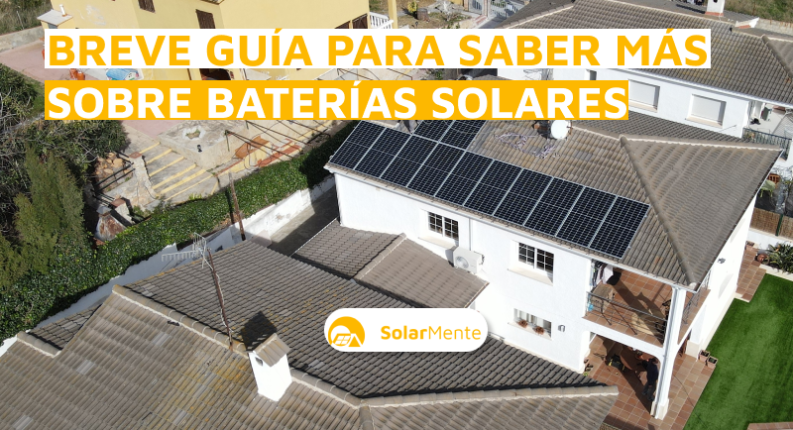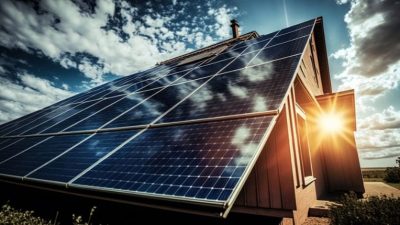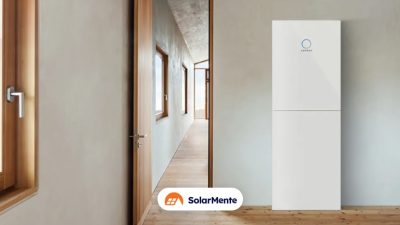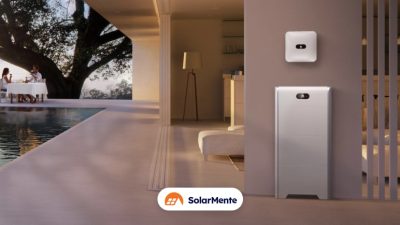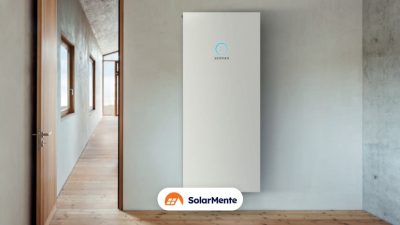A solar battery system – is it the right choice?
This is one of the main questions when installing a photovoltaic system.
Whether you are considering opting for solar energy or you are enjoying the benefits of self-consumption, there are two points that nobody can take away from your mind: obtaining more economic savings on your monthly bill and reducing your dependence on the conventional electricity grid.
The truth is that not only are you betting on a clean and inexhaustible source to reduce the consumption of fossil fuels, but these solar accumulators allow you to make the most of the potential of solar panels.
Thus,all the energy produced is stored without the need to feed it into the grid.
In this article, we will look at:
- What are solar panel batteries and how do they work?
- The types of batteries on the market
- The cost of a solar battery
- The advantages and disadvantages of these elements
- Is it advisable to disconnect from the grid with batteries?
- The manufacturers that we at SolarMente support
What are solar batteries and how do they work?
Batteries allow consumption of the solar energy generated by the solar panels in a period after production.
Let’s put it this way.
As a general rule, the consumption needs of a household work in a similar way in any geographical area. The most energy-intensive hours are in the morning, when we get ready for work, or at night when we need lighting and use various electronic devices;
But what happens during all that time when we are not at home? It is clear that the demand for energy decreases, however, this is the most productive period for generating electricity by means of the photovoltaic system.
Therefore, we are facing a surplus of energy. Our panels are working and we are not being able to make use of them.
Two situations can occur here:
- If you do not have a solar battery, this surplus will be fed into the grid and you will receive financial compensation for it. This is known as surplus compensation.
- Add a solar storage tank, and you can store the generated surplus to enjoy it at night when the sun is no longer shining;
This connection between the solar panels and the batteries is made by means of a solar inverter, the brain of the system that allows the energy produced by our panels to be consumed.
What types of solar batteries are available? .
We findvarious types depending on the technology used by the manufacturers.
Choosing between different types and making the right decision requires knowing all the information about these accumulators and what the differences are between them. Not all of them work in the same way for any photovoltaic installation.
Here is the current category:
- Open lead acid batteries
- AGM batteries
- Gel batteries
- Stationary batteries
- Lithium batteries
Open lead-acid batteries.
Open lead acid batterieshave a short life span with only 300 charge cycles.
The technology used is inferior and the primary use is for motorhomes that do not require significant energy consumption. It can discharge up to 60%, while the more advanced ones discharge completely.
Let’s look at an example.
Imagine we have a battery with a capacity of 10 kWh and a discharge of 80%. This means that you should not use more than 8 kWh before recharging the battery again and avoid possible damage, shortening its lifetime. The higher this discharge rate, the more you can use the battery during the day.
In short:
- They require maintenance
- Cheaper due to more basic technology
- Shorter service life
- Lower depth of discharge rate
AGM batteries
They have certain similarities with open lead-acid batteries in their life cycle. Again, we are talking about a reduced lifetime with 500 charge and discharge cycles.
They also discharge up to 60%, being common in low power consumers such as motorhomes. However, the main advantage over the previous model is thatthey do not require maintenance.
They are also maintenance-free.
Gel solar batteries.
Let’s move on to the next category: gel batteries.
They have a longer service life thanks to their 1200 charge cycles. Likewise, they can be discharged up to 60% and are even suitable for home use as long as energy consumption is low.
They have a longer service life thanks to 1200 charging cycles.
Stationary batteries.
We are moving towards a model where the technology is more advanced and has 3,000 charge and discharge cycles.
In contrast to the previously mentioned accumulators, stationary batteries can discharge up to 80%.
The advantage is that the price is not so high and they can be used in large houses or with photovoltaic systems disconnected from the traditional electricity grid.
Solar lithium batteries.
Today, these batteries have a longer service life than the other models with their 6,000 charge cycles up to almost 100% discharge. They are also used for large houses and off-grid systems.
They are lightweight and are capable of supplying electricity to electric cars.
Here are more advantages of lithium batteries:
- They are safe and do not emit gases that are harmful to health.
- They have a superior efficiency that avoids excessive energy losses.
- Low maintenance
- They are guaranteed for 10 years
It is true that the price is higher than other batteries, but the cost reduction was 98% over the last few years.
What is the best battery for storing solar energy? .
There is no one best battery for storing the energy generated with our solar panels, but each one has a series of functions that you need to compare and review to find out if it is suitable for your home.
In order to choose the right model you need to consider the following factors:
- Energy consumption of the house. We must provide the installation company with our daily energy consumption, especially in those months when we receive less solar radiation. Energy consumption of the house;
- System size. The voltage suitable for the installation will depend on the consumption we have mentioned and the power required.
Advantages of adding solar accumulators to your photovoltaic system.
The installation of batteries for the photovoltaic system, provide a number of benefits for your pocket and the environment. These are:
- Having electricity available in the event of unexpected power cuts.
- More energy independence By storing the energy produced during the hours of greatest radiation, it is not necessary to depend on the grid during the hours when there is no light.
- Higher savings in electricity bills. They allow you to use the excess energy produced at night and avoid using the electricity grid, saving up to 80%. Even more so if you have an hourly rate where prices vary according to the time of day and you avoid paying exorbitant amounts at peak times.
- Environmentally friendly. More energy independence, reducing the use of grid-connected energy, thus reducing the carbon footprint by reducing the use of fossil fuels and increasing the use of renewable and clean energies.
How much can I save if I install a solar battery in my home? .
The purchase of a battery represents a higher investment in our photovoltaic installation and, therefore, the payback period is longer compared to systems that do not include this component.
But of course, integrating a solar battery means saving more on the electricity bill. We are talking about up to 80% savings, which more than pays for itself. On the other hand, the compensation of surpluses, whose prices remain between 0.05-0.06 euros, will not bring you significant savings.
And there is a very interesting aspect that occurs in the tariffs with three time discriminating bands.
Those peak hours close to night time (between 18-22h), where prices increase and we cannot take advantage of sunlight, batteries are very useful, especially, in winter.
What is involved in disconnecting from the grid with a solar battery?
Completely disconnecting from the grid is not a recommended decision because of the additional cost and complexity of a full disconnection.
While you are connected to the conventional grid, you have a greater range of possibilities for obtaining electricity in the event of being left without electricity supply due to extreme storms such as rain or uninterrupted snow, exhausting the energy stored in the batteries.
In addition, continuing to be connected to the grid means greater profitability and savings by having to install a smaller system, therefore reducing costs compared to a large system where most of the time the excess energy produced is not used.
A complete disconnection from the grid implies having a large battery storage capacity for daily use and a certain number of solar panels that cover the consumption needs of the home, as well as keeping the batteries charged throughout the day.
It is true that it may be feasible in summer due to more hours of available sunshine coupled with high energy production.
But what happens when winter is just around the corner?
It gets dark earlier and our panels do not produce the same amount of electricity, with the difficulty of generating that excess to be used during the night.
We advise you not to associate the use of batteries with total energy independence. To achieve this, the cost of the installation will be very high compared to a grid-connected system.
Manufacturers of batteries for solar panels: our bet
When choosing a battery for solar panels, you should pay attention to one very important criterion: compatibility with inverters.
For this reason, at SolarMente we work with different battery brands that are compatible with different models of solar inverters and these are:
- Sonnen
- Huawei Luna
- LG Energy
Finally, remember to include hybrid inverters for battery use in your PV system. Otherwise, they will not work.
How much does a solar power battery cost? .
Battery prices vary. For example, a battery with a capacity of 5 kW can cost up to 3,000 euros, while higher capacities can easily reach 5,000 euros.
The calculation of the power of a battery is generally based on the energy we need until the next day;
The situation changes drastically when we want an off-grid system with total independence from the grid.
The cost of the installation could exceed 25,000 euros as it requires a larger number of panels with a fairly high power to cope with any inclement weather and not run out of electricity at any time, i.e. to be able to easily self-supply.
On the other hand, their main advantage lies in the event of a power cut. In this case, electricity can be used without any problems. On the other hand, battery systems connected to the grid will not be supplied for safety reasons.
How can this be solved? By having a backup box or emergency exit that allows energy to be consumed in the home in the event of unexpected power cuts.
Are solar batteries eligible for subsidies?.
Solar accumulators are also eligible for subsidies in the same way as solar panels. In this case, we are talking about the subsidies for self-consumption belonging to the Next Generation Funds.
What are the requirements you must meet?
You must have an already installed and legalised photovoltaic installation, regardless of whether the batteries have been contracted with the same solar company or you have decided to change it.
In the case of having an installation from years ago, you will be able to apply for aid without any problem. The access will be the same for all the autonomous communities of the country.
However,what is the subsidy to be obtained?:
- For an installation with a capacity of 10 kWh or less, the subsidised amount will be 490€/kWh.
- For batteries above 15 kWh, the subsidy received will be 350€/kWh.
But be careful with applying for this bonus if you already have another active bonus. You will not be able to apply until the previous application has been successful.
If you have not yet installed solar panels on your roof and you are considering acquiring a system together with a battery, we recommend you take a look at theaid available in the community of Catalonia:
- Self-consumption in Barcelona.
- Installation of solar panels in Girona
- Photovoltaic installation in Lleida
- Solar panels in Tarragona
Reducing your electricity bill with solar batteries.
Installing batteries for solar panels provides greater independence from your energy supplier, but the total disconnection from the grid entails certain problems due to not having enough energy for your home’s energy consumption.
However, it is an interesting alternative for increasing savings on your electricity bill or for homes in isolated areas where access to the grid is difficult.
In any case, taking the leap towards self-consumption is already beneficial for you. And if you still don’t know how much you can save, Stop by our solar calculator and you’ll see how your pocket will thank you every month.
Frequently asked questions.
What is the lifetime of a solar home battery?
The lifetime of a solar battery can be up to 15 years with proper maintenance.
How much energy can be stored in a solar battery? .
The capacity of a solar battery is measured in kilowatt-hours (kWh) and, depending on the manufacturer, there are models that store more or less energy.
Within the manufacturers we work with, capacities vary from 4-5 kWh to over 20 kWh for larger homes where a higher percentage of energy consumption needs to be covered.
However, to obtain a higher storage capacity, many models can be linked together in an interconnected design.

